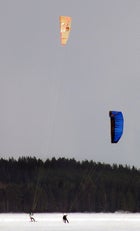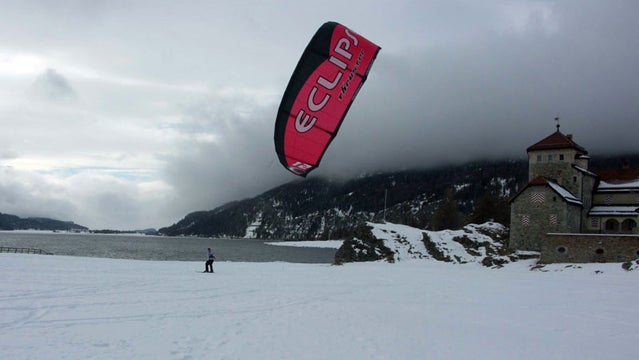Consider snowkiting, a full-body resistance workout similar to (but easier than) kitesurfing. “Snowkiting is easy to learn, and all you need is an open area with some wind and snow,” says pro snowkiter Jon McCabe, who recommends two different ways to learn the sport.
 Snowkiting on Lake Kallavesi, Finland.
Snowkiting on Lake Kallavesi, Finland.Option No. 1 is to purchase a smaller kite (2-4 meters) and teach yourself to fly it in moderate winds (you don’t even need snow for this part). Then, slowly integrate skis or a snowboard.
“Buying a small trainer kite, reading your kite manual, and watching online videos will help you get started on the path of learning how the wind works,” explains ‘ Tom Fredericks, who has more than 10 years of snowkiting experience. “You have to identify the geography of your area and know where to find open snow-covered terrain or frozen lakes—anywhere that there is plenty of room with no obstacles that has wind and snow.”
The other—and much faster—option is to take a lesson from a professional. “Within 10 minutes you will be snowkiting,” says McCabe, an organizer of , a grassroots festival that takes place March 28-31 at the in Girdwood. “Personally, I recommend a little of both for the most success, but if you don’t have a lot of free time, then go with the lesson right from the start.”
Fredericks agrees: “Start out small, and then seek professional instruction and learn to fly a bigger four-line kite.” Pros can also dish out advice on the best—and worst—local riding areas, weather, and wind patterns. “The instructors and experts around your area will be able to direct you to places that are legal, such as frozen lakes, state lands or parks, or federal lands and parks,” he says, noting that farmers’ fields are also ideal, so long as you have permission from the landowner.
Lessons or not, you’ll need ski or snowboarding equipment, a kite, a harness, and a helmet. Kites can be foil or inflatable, and are typically available in three sizes: small (6m) for strong winds, and medium (9m) or large (14m) for medium and light winds, respectively.
And speaking of wind, you need to understand it. “The quality of the wind is everything,” Fredericks says. “If you have good-quality wind, which means steady, consistent, and not gusty, you can snowkite in almost any kind of snow and weather condition.” Winds more than 25mph are considered dangerous.
Like most sports, snowkiting can be as easy or as challenging as you make it. “If you want to just ride back and forth across the lake, that’s great,” Fredericks says. “If you want to jump and do freestyle or wakeboard-type moves with the kite, that’s awesome. If you want to ride up the side of a mountain, pack the kite up at the top, then ski down, why not? If you want to ride up, then fly off the side of a mountain, there are a few people that do that as well.”
The sky’s the limit. Literally.


